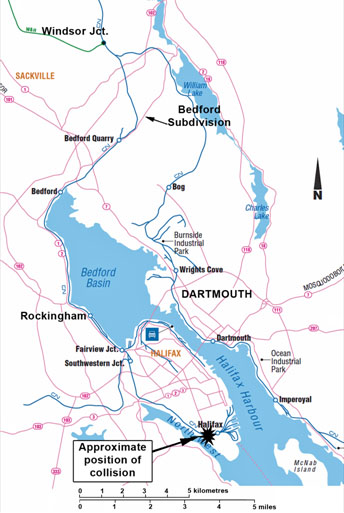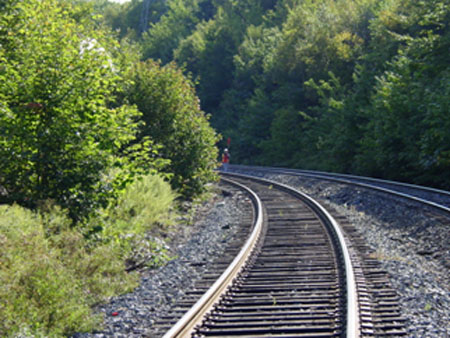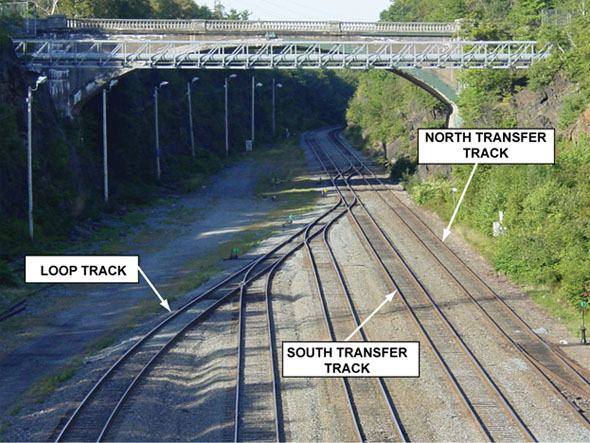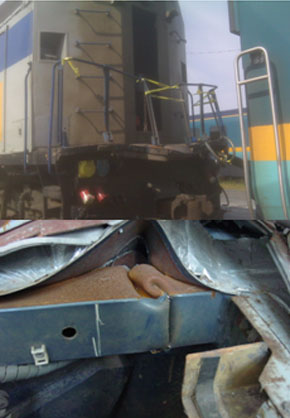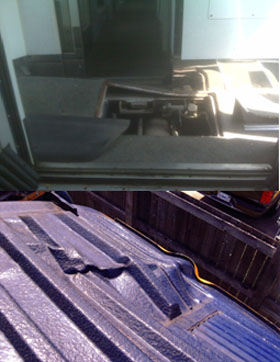Non-main-track collision
Between Canadian National train Q121-11-03
and VIA Rail Canada Inc. train P614-21-02
Mile 1.3, Canadian National Bedford Subdivision
Halifax, Nova Scotia
The Transportation Safety Board of Canada (TSB) investigated this occurrence for the purpose of advancing transportation safety. It is not the function of the Board to assign fault or determine civil or criminal liability. This report is not created for use in the context of legal, disciplinary or other proceedings. See Ownership and use of content. Masculine pronouns and position titles may be used to signify all genders to comply with the Canadian Transportation Accident Investigation and Safety Board Act (S.C. 1989, c. 3).
Summary
On 03 July 2008 at 1837 Atlantic daylight time, VIA Rail Canada Inc. (VIA) train P614-21-02 was moving westward exiting a loop track before returning to the Halifax VIA station. There were seven maintenance employees and two crew members on board. Simultaneously, Canadian National (CN) Train Q121-11-03, operating eastward with two crew members, was reversing towards Halifax Ocean Terminals. At Mile 1.3 of the CN Bedford Subdivision, in an area where sightlines were restricted due to the curvature of the track and a rock cut, the two movements collided at low speed. As a result of the collision, there was substantial damage to the two locomotives and the first six cars of the VIA train. There was minimal track damage and there were no serious injuries.
Ce rapport est également disponible en français.
Factual information
Train information
Canadian National (CN) train Q121-11-03 (the CN train) consisted of four locomotives, weighed approximately 790 tons, and was about 285 feet in length. The fourth locomotive was shut down, but the brakes were operative. The engines were proceeding from the CN Fairview shop tracks in Halifax, Nova Scotia, on the Bedford Subdivision to pick up container cars at Halifax Ocean Terminals (HOT) (see Figure 1).
VIA Rail Canada Inc. (VIA) train P614-21-02 (the VIA train) was powered by two locomotives, consisted of 19 Renaissance passenger cars and 1 baggage car, weighed approximately 1400 tons, and was about 1650 feet in length. Because of the Canada Day public holiday, it had five additional cars and was 425 feet longer than usual. The train had arrived 47 minutes late at the Halifax station from Montréal, Quebec.
Crew information
The crew of the CN train, a locomotive engineer and a conductor, came on duty at 1800Footnote 1 on 03 July 2008 at Fairview Shops. The locomotive engineer was at the controls in the first locomotive, on the west end. The conductor was positioned in the right-hand seat of the fourth locomotive (which was leading) as the movement was reversing eastward. He was providing movement instructions to his locomotive engineer over a handheld radio on channel 1.
The crew of the VIA train, an operating locomotive engineer and an in-charge locomotive engineer, came on duty at Moncton, New Brunswick, at 1100. For clarity, the in-charge locomotive engineer will be referred to as "conductor" throughout the body of the report. The locomotive engineer was positioned at the controls in the first locomotive, which was leading, as they pulled westward. The conductor was in the last car at the east end of the train, providing switching instructions using a handheld radio on channel 1.
All employees were qualified for their respective positions and met company and regulatory fitness and rest standards.
Bedford Subdivision
The Bedford Subdivision is composed of a single main track that extends between the entrance to HOT, Mile 1.6, and Truro, Mile 64. Train movements between Truro and Fairview Junction, Mile 5.1, are governed by the Centralized Traffic Control System (CTC) as authorized by the Canadian Rail Operating Rules (CROR) and supervised by a rail traffic controller located in Montréal.
Between Mile 5.1 and Mile 1.6 ("the HOT-Rock connecting track"), movements are governed by subdivision trackFootnote 2, but require exclusive authority from the traffic coordinator at Rockingham, Mile 6.0.
In HOT, between Mile 0 and 1.6, movements are governed by CROR Rule 105. A train must proceed at reduced speedFootnote 3 and not exceed 15 mph. HOT consists of approximately 80 non-main tracks and handles import and export traffic.
In the accident area, the track is approximately a four-degree curve and a one per cent descending grade for eastward movements. The sightlines were restricted due to vegetation, the curvature of the track, and the deep rock cut (see Photo 1).
Canadian National train activities
As the CN train was approaching Mile 1.6, its locomotive engineer had slowed the movement to 15 mph. The train was proceeding around a four-degree curve at Mile 1.3 on the north transfer track when the conductor first noticed the VIA train ahead. He believed that the train was stopped, and transmitted "three car lengths" over the radio to his locomotive engineer. He immediately realized that the VIA train was moving and instructed the locomotive engineer to initiate emergency braking.
The CN train was operating on schedule, scanning radio channel 1, the standby channel open to all crews. The crew could hear the VIA train switching, but did not know its exact location. These trains seldom encountered each other. When they did, the passenger train was usually switching in the loop track at HOT, clear of the CN transfer tracks. When the crew on the CN train obtained authority for the HOT-Rock connecting track from the traffic coordinator, there was no mention about the delay to the VIA train.
VIA Rail Canada Inc. train activities
After its arrival at the station, the VIA train reversed westward on the north transfer track (see Photo 2) and entered the loop track at HOT. After completing the loop, the VIA train came back towards the north transfer track because the switches were already lined. The crew planned to stop and reverse eastward on the south transfer track into the Halifax VIA station. The VIA conductor remained at the east end of the train, in order to restore the derail for the loop track and to line the switches.
The conductor gave the locomotive engineer instructions to move five car lengths westward to clear the south transfer track switch. After moving about three car lengths, the locomotive engineer started throttling down while moving at 13 mph in preparation to stop. When he heard the CN conductor call his locomotive engineer, he put the VIA train into emergency. Shortly after, the trains collided (see Figure 2).
Damage
Subsequent inspection revealed that no equipment derailed. However, some of the vestibules and roofs of the Renaissance equipment were buckled.Footnote 4 The two VIA locomotives, a baggage car and five coaches were severely damaged (see Photo 3). No one was seriously injured. There was minimal track damage.
At the time of the accident, the weather was mostly cloudy, with winds from the south‑southwest at 22.2 km/h and a temperature of 22°C.
Locomotive event recorders
Examination of the locomotive event recorders of each train revealed the following:
CN train
- The emergency brake application was made while the train was proceeding at 15 mph with a fully charged brake pipe and the throttle in the idle position.
- Five seconds later, while the train was proceeding at 12 mph, there was a sudden deceleration and a fluctuation in the brake cylinder pressure.
- Approximately eight seconds after the emergency brake application, all movement came to a stop.
VIA train
- The emergency brake application was made while the train was proceeding at 13 mph with a fully charged brake pipe and the throttle in the No. 1 position.
- Seven seconds after the emergency brake application, train speed had reduced from 6 to 3 mph.
- Deceleration stopped for one second at 3 mph.
- Eleven seconds after the emergency brake application, all movement came to a stop.
Reduced speed – Range of vision and stopping distances
In areas where CROR Rule 105 is in effect, movements at reduced speed typically must not exceed 15 mph. However, several railways in Canada have capped the speed restriction that applies to Rule 105 to 10 mph when operating on non-main tracks other than sidings.
In subdivision track, reduced speed can be as high as the zone speed indicated in the timetable. On various CN subdivisions across Canada, there are locations designated as subdivision track with the maximum speed in the timetable varying from 15 mph up to 50 mph.
Simulations conducted by the TSB at the accident site with two consists similar to the ones involved in the occurrence showed the following:
- The range of vision was 340 feet for the CN train and 320 feet for the VIA train.
- The train stopping (braking) distance for the CN train was 210 feet at 10 mph, and 320 feet at 15 mph.
- The train stopping distance for the VIA train was 50 feet at 10 mph, and 140 feet at 15 mph.
Non-main-track collisions
According to the TSB railway occurrence database, between September 2003 and September 2008, there were 410 collisions on other than main track. Among these, 10 collisions involved at least one VIA train and, in 7 of these collisions, one or both of the trains were reversing.
After an occurrence in Calgary, Alberta (TSB report R93C0103), the TSB issued Rail Safety Advisory (RSA) 04/94 and Board Recommendation R95-02 to address deficiencies identified in Rule 105 territory. The TSB suggested that Transport Canada (TC) may wish to review communication procedures between railways when operating on common switching territories and recommended that:
The Department of Transport review the application of CROR Rule 105 with a view to ensuring that an appropriate safety factor is maintained with opposing movements. (R95-02, issued June 1995)
In response, TC stated that "Ultimately, the issue appears to be one of non-compliance with fundamental rules of railway operations, and not the adequacy of the rule." While TC considered the recommendation closed, some segments of the industry have voluntarily adopted more restrictive measures when Rule 105 is in effect (see above). Based on these changes, TC's response was reassessed by the TSB as Satisfactory in Part.
Subsequent to TSB investigations R96Q0050, R99T0021, and R06V0111, the Board determined that the lack of communication between crews and other persons involved was not conducive to a heightened level of awareness about the presence of other movements.
Analysis
There were no mechanical deficiencies noted with the trains and no track problems that contributed to this accident. Both crews were fully acquainted with the trains they were handling as well as the territory on which they were operating. The analysis will therefore focus on the adequacy of safety defences when opposing movements are proceeding at reduced speed in territory where Rule 105 or subdivision track is in effect, particularly where passenger trains operate in conjunction with freight trains.
The accident
Because VIA train's locomotive engineer was in the process of stopping clear of the south switch, his concentration was on reducing the throttle position and avoiding slack action. As the CN train was proceeding around the four-degree curve at Mile 1.3 where visibility was restricted by a rock cut, the conductor instructed the locomotive engineer to initiate emergency braking when he saw the VIA train coming. Both locomotive engineers heard his call and applied the emergency brakes; however, the movements could not be stopped in time and the trains collided.
According to the locomotive event recorder data, the CN train was travelling at 15 mph and the VIA train at 13 mph when the emergency brakes were applied. Variations observed in the decelerations indicate that the collision occurred when the CN train speed dropped to 12 mph, while the VIA train speed had reduced to between 6 and 3 mph. Because the CN locomotive that was heading the movement was inoperative, its speedometer was not working; therefore, the conductor did not have an exact indication of train speed.
The stopping distance of the VIA train was approximately 140 feet, while CN required 320 feet. Therefore, the collision was unavoidable at the speed at which the trains were proceeding because the combined stopping distances exceeded the range of vision, which was slightly more than 300 feet. Tests showed that the VIA train would have been able to stop within one-half the range of vision of equipment. However, the CN train stopping distance was close to the entire available distance of visibility. It would not have been able to stop within one-half the range of vision, even though the CN conductor alerted both locomotive engineers eight or nine seconds before the impact. Had the speed been restricted in this curve to 10 mph, as several Canadian railways have done on non-main tracks, the range of vision and the stopping distance could have been sufficient to avoid the collision.Footnote 5
The VIA train had five additional cars due to Canada Day passenger traffic. Therefore, it needed to move further westward than usual to clear the tail end of the train for the transfer tracks. This placed the leading end of the VIA train in a location seldom encountered by other crews and in the curved part of the rock cut, where the sightlines were the most restrictive.
The CN crew could hear the VIA train switching on radio channel 1, but did not know its exact location. These trains seldom encountered each other. When they did, the passenger train was usually switching in the loop track, clear of the CN transfer tracks. However, because of the later arrival of the VIA train that day, its switching tasks coincided with the CN train entering HOT. This resulted in the two opposing trains operating on the same portion of the HOT track without being aware of each other. For both of these experienced train crews, who were performing regular manoeuvres, the usual cues (auditory, visual, and mental model) did not alert them to each other's presence in time to avoid a collision.
Application of reduced speed
CROR Rule 105 and subdivision track govern speed as a function of the range of vision and the stopping capability of the train, and employees must reduce speed accordingly. To be in compliance with the rule, crew members must assess the changing variables upon which the range of vision and stopping capability depend. Range of vision is affected by physical layout and obstructions, weather, and ambient lighting. The stopping distance depends on track characteristics, the weight of the train, braking efficiency, and crew reaction time. An inaccurate estimate of either one-half the range of vision or the stopping distance could result in a movement proceeding at an inappropriate speed.
Crew members may make an inaccurate estimate of stopping distance due to an unfamiliarity with how well the brakes will work (for example, a conductor making an assessment of adequate speed when the locomotive engineer controls the brakes) or an underestimation of train weight/grade/degree of curvature. Similarly, crew members may make a poor estimate of the range of vision, even if they accurately assess stopping capability. Additionally, if the crew
is tasked with other duties such as those required during switching, the ability to concentrate specifically on approaching movements may be affected. Consequently, with many of these variables in play at any one time, the possibility of misjudging the speed from which a safe stop can be achieved is significant.
Safe operating practices would therefore dictate that a safety factor be built into the required stopping distance. For most circumstances, reduced speed does this. Application of reduced speed to determine the speed that would allow a safe stopping distance between a moving unit and a stationary object provides a safety factor of two, that is, a speed that permits stopping within one-half the range of vision. However, when calculating the distance required by two movements that unexpectedly meet, as happened in this occurrence, it is found that the safety margin could be non-existent. In other words, if each movement uses the entire distance as permitted by its speed (one half its range of vision), there could be virtually no space left between the two after they brake to a stop. If either train exceeds the available distance by any amount, the other must do better than that standard, by at least the same amount, or there will be a collision. While reduced speed provides a safety buffer in the case of stopping distance between a moving unit and a stationary object, in an opposing traffic situation, even the most competent crews would have difficulty assessing the variables in time to effectively comply with reduced speed.
In reverse movements, the locomotive engineer cannot usually see the track ahead and relies on the conductor to provide perceived distance measurements by radio, which must be acknowledged, processed, and acted upon accordingly. Research has shown that the typical reaction time of a person to unexpected stimuli is 0.5 to 2 seconds under "normal" workload conditions, but can lengthen up to 4 seconds in "abnormal/high" workload situations.Footnote 6 By the time the CN conductor perceived the impending collision with the VIA train ahead and relayed the emergency to his locomotive engineer, available stopping time was diminished. TSB data show that 7 out of 10 collisions involving at least one VIA train occurred while one of the trains was backing up; this would suggest that being able to stop within one-half the range of vision of equipment is negatively affected when operating in reverse.
There are thousands of movements conducted successfully all across Canada at reduced speed, in territory where Rule 105 or subdivision track is in effect. However, the accident record shows that, in the last five years, there were over 400 collisions on non-main track. These data demonstrate once again that dependence on strict compliance with the operating rules as the primary defence against train collisions is not always effective in preventing a collision between train movements on other than main track. The TSB has brought this issue to the attention of TC and the industry in the past, but no additional safety defence barrier has been introduced to enhance safety in non-main track where reduced speed is used.
It is important to note that any such collision is generally at very low speed. The outcomes of these collisions primarily involve damage to equipment, and, if crew members sustain injuries, they are usually minor in nature. But, with the introduction of subdivision track, reduced speed
is not capped at 15 mph and can be as high as the maximum zone speed. Therefore, in subdivisions where passenger trains operate, the consequences associated with any collision are increased because passengers as well as crew members can be exposed.
A common factor between this accident and previous collisions investigated by the TSB is the lack of information available to train crews about concurrent movements of other trains or engines on shared territory. Communications between the traffic coordinator and the CN train crew and the lack of communication between the two crews involved did not assist the crews in identifying each other's whereabouts. Ensuring that all persons involved are aware of the most up-to-date, accurate information concerning the movement of trains and engines would alleviate some of the risk associated with the complexity of applying reduced speed effectively on non-main track. In the absence of relevant information concerning opposing movements, crews may not always be able to apply reduced speed effectively in territory where Rule 105 or subdivision track is in effect.
Renaissance equipment – Crash management zones
Due to their shock-absorbing capabilities, the VIA Renaissance cars are less likely to derail upon frontal impact with other equipment. The crash management zones on the Renaissance equipment functioned as designed and helped to protect the crew members and the maintenance employees who were on board from injurious impact forces (LP 023/09Footnote 7).
Findings
Findings as to causes and contributing factors
- The collision occurred in an area of restricted sightlines when the opposing trains were unaware that they were on the same track.
- The collision was unavoidable at the speeds at which the trains were proceeding.
- The VIA Rail Canada Inc. train would have been able to stop within one-half the range of vision. The Canadian National train stopping distance was close to the entire available distance of visibility and the train would not have been able to stop within one-half the range of vision.
- Both train crews seldom met the other movement on the transfer tracks and did not expect to encounter each other, and neither train was advised of the presence of the other.
Findings as to risk
- Reduced speed presupposes that crews will be able to assess all the variables involved in such movements in time to avoid a collision. This does not provide adequate defence in a situation of opposing movements, particularly where passenger trains operate.
- In the absence of relevant information concerning opposing movements, crews may not always be able to apply reduced speed effectively in territory where Rule 105 or subdivision track is in effect.
Other finding
- The crash management zones on the VIA Renaissance equipment functioned as designed and helped to protect the crew members and the maintenance employees from injurious impact forces.
Safety action taken
Following the accident, Canadian National (CN) officers met with all local train crew employees to confirm their understanding of reduced speed and to ensure that they were aware of the need to proceed at much less than the maximum allowable 15 mph in locations with restricted visibility, such as that where the accident occurred.
CN also will convert the section of track between Mile 1.6 and Mile 5.1 from subdivision track to Occupancy Control System (OCS) control by the end of 2009.
Safety concern
Although there are thousands of movements conducted successfully all across Canada at reduced speed, in territory where Rule 105 or subdivision track is in effect, the accident record shows that, in the last five years, there were over 400 collisions on non-main track. These collisions are generally at very low speed and the outcomes primarily involve damage to equipment, but they nevertheless demonstrate that dependence on strict compliance with operating rules as the primary defence against train collisions is not always effective. Furthermore, with the introduction of subdivision track, reduced speed is not capped at 15 mph and can be as high as the maximum zone speed. Therefore, the Board is concerned that on subdivisions where passenger trains operate, passengers as well as crew members may be exposed to increased risks when Rule 105 or subdivision track is in effect.
This report concludes the Transportation Safety Board's investigation into this occurrence. Consequently, the Board authorized the release of this report on .
Appendices
Appendix A – Canadian Rail Operating Rules definitions and Canadian National special instructions
Canadian Rail Operating Rules (CROR) definitions
Subdivision track
A Non-Main Track so indicated in the time table method of control column that is an extension of the main track, and the through track at that location, defined with subdivision mileage signs. REDUCED speed is applicable to a maximum speed as indicated in the time table.
Reduced speed
A speed that will permit stopping within one-half the range of vision of equipment.
Rule 105 – Speed on non-main track
Special instructions will indicate when this rule is not applicable on a specific track.
Unless otherwise provided by signal indication, a movement using non-main track must operate at REDUCED speed and be prepared to stop short of the end of track or the red signal prescribed by Rule 40.1.
- In CTC, movements may only enter a siding by signal indication or with permission from the RTC [rail traffic controller].
- Unless otherwise provided by signal indication or special instructions, movements operating on non-main tracks must not exceed fifteen (15) MPH.
- In addition to moving at REDUCED speed, a movement using a non-signalled siding or using other non-main tracks so designated in special instructions, must operate at a speed that will allow it to stop within one-half the range of vision of a track unit.
Note: Not applicable where Siding Control Territory rules are in effect.
